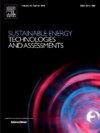超级电容器用非晶sn2p2o7合金的制备及性能评价
IF 7
2区 工程技术
Q1 ENERGY & FUELS
Sustainable Energy Technologies and Assessments
Pub Date : 2025-06-05
DOI:10.1016/j.seta.2025.104383
引用次数: 0
摘要
本研究的重点是评价通过脱合金工艺获得的可能的焦磷酸盐超级电容器材料的储能性能。采用循环伏安法(CV)、恒流充放电法(GCD)和电化学阻抗谱法(EIS)研究了三电极电池在1 M KOH电解质溶液中的电化学行为。直接评估了脱合金时间对电容的影响,表明部分脱合金改善了储能。此外,对合成材料的形态结构进行了研究,以表征材料在浸泡时间为3 ~ 24 h时的行为。结果表明,在5 mV s−1的扫描速率下,浸泡时间为3 h时,电极的CV分析测得的电容值最高,约为269.36 mF cm−2。GCD结果也证实了电极材料的优越性,在1 mA cm−2下,电极在浸泡3 h时的最大比电容为268.7 mF cm−2。所有合成电极都表现出良好的循环稳定性,保留率超过100%。在500次以上24 h的浸泡时间下,所得电极的保留率约为129.33%。此外,还根据实验程序组装了水对称超级电容器。根据CV数据计算电容值作为电位窗口和扫描速率的函数。CSP-12 h//CSP-12 h对称超级电容器在1.4 V电压下电容最高,达到49.24 mF cm−2。CSP-24 h//CSP-24 h器件在5 mV s−1下的电容值最高,达到45.72 mF cm−2。GCD测量作为电位窗口的函数表明,CSP-6 h//CSP-6 h和CSP-12 h//CSP-12 h器件表现出最佳性能,在1.4 V下达到最高电容值约为46 mF cm−2。此外,csp - 12h // csp - 12h器件在0.027 mWh cm - 2的能量密度下提供了5.46 mW cm - 2的功率密度。经过3000次循环,CSP-3 h//CSP-3 h装置的最大保留率约为30.42%。本研究提出了一种很有前途的生产超级电容器用焦磷酸盐材料的技术。本文章由计算机程序翻译,如有差异,请以英文原文为准。
Fabrication and performance evaluation of the NPC/amorphous-Sn2P2O7 by dealloying of CuNiSnP alloy for supercapacitor application
Present study focuses on the evaluation of the energy storage performance of possible pyrophosphate supercapacitor materials obtained by dealloying process. The electrochemical behavior was investigated by cyclic voltammetry (CV), galvanostatic charge–discharge (GCD) and electrochemical impedance spectroscopy (EIS) techniques using a system based on three-electrode cell in 1 M KOH electrolyte solution. A direct assessment of the influence of dealloying time for capacitance was performed, showing that partial dealloying improves energy storage. Furthermore, the synthesized materials were investigated morpho-structurally to present behavior of the materials at immersion times between 3 and 24 h. Obtained results presents that the highest capacitance value about 269.36 mF cm−2 measured from CV analysis was observed for the electrode at 3 h immersion time at 5 mV s−1 scan rate. The GCD results confirmed also the superiority of the electrode material by recording the maximum specific capacitance of 268.7 mF cm−2 at 1 mA cm−2 calculated for the electrode at 3 h immersion time. All the as-synthesized electrodes presented an excellent cyclic stability showing an increase in retention rates over 100 %. For the as-obtained electrode a retention rate about 129.33 % at 24 h immersion time over 500 cycles, was obtained. In addition, aqueous symmetric supercapacitors were assembled based on the experimental program. Capacitance values were calculated from the CV data as a function of potential window and scan rate. The highest capacitance was observed for the CSP-12 h//CSP-12 h symmetric supercapacitor, reaching 49.24 mF cm−2 at 1.4 V. As a function of scan rate, the CSP-24 h//CSP-24 h device exhibited the highest capacitance, reaching 45.72 mF cm−2 at 5 mV s−1. GCD measurements as a function of potential window showed that the CSP-6 h//CSP-6 h and CSP-12 h//CSP-12 h devices demonstrated the best performance, with the highest capacitance values of approximately 46 mF cm−2 achieved at 1.4 V. Furthermore, the CSP-12 h//CSP-12 h device delivered a power density of 5.46 mW cm−2 at an energy density of 0.027 mWh cm−2. Over 3000 cycles, the maximum retention rate was approximately 30.42 %, observed for the CSP-3 h//CSP-3 h device. This research presents a promising technique for producing pyrophosphate material for supercapacitor application.
求助全文
通过发布文献求助,成功后即可免费获取论文全文。
去求助
来源期刊

Sustainable Energy Technologies and Assessments
Energy-Renewable Energy, Sustainability and the Environment
CiteScore
12.70
自引率
12.50%
发文量
1091
期刊介绍:
Encouraging a transition to a sustainable energy future is imperative for our world. Technologies that enable this shift in various sectors like transportation, heating, and power systems are of utmost importance. Sustainable Energy Technologies and Assessments welcomes papers focusing on a range of aspects and levels of technological advancements in energy generation and utilization. The aim is to reduce the negative environmental impact associated with energy production and consumption, spanning from laboratory experiments to real-world applications in the commercial sector.
 求助内容:
求助内容: 应助结果提醒方式:
应助结果提醒方式:


